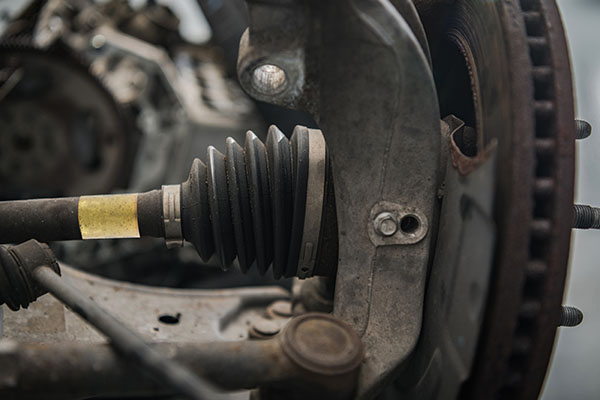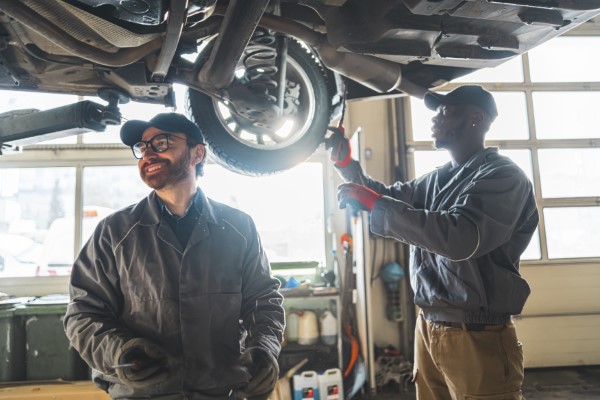Posted on 3/20/2024

Ball joints may be inconspicuous, but they play a pivotal role in your car's suspension system. These small, spherical components connect the control arms to the steering knuckles, facilitating the smooth movement of your vehicle's wheels. Their design allows for flexibility and controlled articulation, enabling the wheels to move up and down while responding to steering input. What Do Ball Joints Do in Your Vehicle? Ball joints are integral to the proper functioning of your car's suspension system, providing essential connections between various components. Here's a breakdown of their crucial roles: 1. Facilitating Movement Ball joints allow controlled movement of the suspension components, enabling the wheels to move vertically in response to road imperfections. This flexibility ensures a smoother ride and improved handling. 2. Steering Responsivene ... read more
Posted on 2/29/2024
%20(1).jpeg)
Have you ever wondered how your car's engine transforms fuel into power? Enter the carburetor, a vital yet often overlooked component in traditional internal combustion engines. What is a Carburetor? A carburetor is a mechanical device found in older gasoline-powered vehicles that mixes air and fuel in the correct ratio for combustion in the engine. Acting as the "lungs" of your vehicle, the carburetor delivers this combustible mixture to the engine cylinders, where it's ignited to produce power. How Does a Carburetor Work? When you press down on the accelerator pedal, it opens a valve in the carburetor, allowing air to flow into the engine. Simultaneously, the carburetor meters the appropriate amount of fuel from the fuel reservoir and mixes it with the incoming air, creating a highly combustible mixture known as the air ... read more
Posted on 1/31/2024
.jpeg)
Brake squeals—those high-pitched, nerve-wracking sounds that can turn a smooth drive into an auditory nightmare. If you've ever cringed at the screeching sounds emanating from your vehicle, you're not alone. Below are the top 8 reasons behind this common automotive woe, and explore how you can put the brakes on the sound itself. 1. Worn Brake Pads One of the most common reasons for brake squeals is worn brake pads. Over time, the friction material on the pads wears down, leading to metal-on-metal contact that manifests as that unmistakable screech. Regular inspections and timely replacement of worn brake pads can prevent this issue. 2. Buildup of Brake Dust Brake dust, a byproduct of braking, can accumulate on the brake pads and rotors. When this fine powder builds up, it may cause friction and result in squealing noises. Regular cle ... read more
Posted on 12/24/2023

As you embark on the daily journey with your trusty vehicle, the heartbeat of its power lies within the carburetor—a seemingly small yet integral component that plays a vital role in the performance of your car's engine. In this guide, we'll explore the art of maintaining and nurturing your car's carburetor, ensuring that it continues to deliver an even distribution of power and efficiency on the road. How Does The Carburetor Work? The carburetor is a crucial component in older internal combustion engines that blends air and fuel in the right proportions before supplying the mixture to the engine for combustion. Here's a brief explanation of how the carburetor works: Air Intake: As the engine runs, it draws in air through the air filter. Fuel Delivery: Simultaneously, the carburetor meters the a ... read more
Posted on 11/29/2023
.jpeg)
Your car's air conditioning, the component bringing comfort to your automotive adventures, might hint at a need for some attention. After all, your A/C silently works to keep you cool or cozy, and it's high time we tuned in to its signals - let's explore five common signs that your vehicle might be secretly grappling with air conditioning issues. Whispering or Noisy Vents Ever felt like your A/C vents were telling you a secret? If you've noticed a subtle whistle or wheeze escaping from these metal orifices, it's not just the wind playing tricks. This could be your A/C system's way of signaling that something is amiss. The whispering vents might be a cry for help, indicating issues with the blower motor or a potential blockage in the system. Problem With Air Temperature You hit the A/C button, eagerly anticipating the icy air, but all you get is a lukewarm breeze - has this happened? If your car fails to deliver the refreshin ... read more